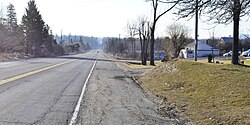Scotch Block, Ontario
| Scotch Block | |
|---|---|
| Unincorporated community | |

Looking south on Highway 25 in Scotch Block
|
|
| Location of Scotch Block in Canada | |
| Coordinates: 43°34′19″N 79°57′39″W / 43.57194°N 79.96083°WCoordinates: 43°34′19″N 79°57′39″W / 43.57194°N 79.96083°W | |
| Country | Canada |
| Province | Ontario |
| Regional municipality | Halton |
| Town | Halton Hills |
| Time zone | Eastern (EST) (UTC-5) |
| • Summer (DST) | EDT (UTC-4) |
| GNBC Code | FDVUT |
Scotch Block is an unincorporated community in Halton Hills, Ontario, Canada.
Settlers arrived in the early 1800s, and Scotch Block encompassed approximately 35 square kilometres (10 sq mi) of agricultural land in southwestern Esquesing Township.
Sixteen Mile Creek flows through the settlement, and the present-day Scotch Block Dam and Reservoir is located there. Scotch Block is located on the Niagara Escarpment, and a portion of the Bruce Trail passes through it.
James and John Stewart, early settlers from Perth, Scotland, made a request to the government in 1819 for a Scottish settlement in Esquesing Township. That same year, James McNab, a land promoter living in Toronto Township, petitioned to bring 30 families of Scottish origin to Ontario from the economically depressed towns of Barnet and Ryegate in the US state of Vermont. Both towns had been founded by a group-migration from Scotland in the late 1700s, and many then migrated to the Scotch Block area. Other Scotch Block settlers arrived directly from Scotland, the majority from the Perthshire and Roxburghshire regions. Another Scottish family, the Laidlaws, moved first to Nova Scotia, and then to Scotch Block.
The settlement was at first referred to as "The Scotch Settlement" and "The Settlement", but eventually became known as "The Scotch Block". It was the most ethnically homogeneous region in the county, its first settlers "Scotch almost without exception".
An early settler, James Laidlaw, described The Scotch Block in a letter to his cousin in Scotland in 1819:
We are mostly all Scotchmen and have got a township to be all together, or what is called a parish in Scotland. They give 60,000 acres for one Township. There are a great many people settling here. Government has bought a large tract of Country from the Indians last year. One end of it was about twelve miles from York and very good land so that people are all going on it, it being so near the capital of the Province... The money here with merchants and people and trade is as plenty as ever I saw it in any town in Scotland. There is a market here every day for veal and mutton, and people come in from the County with butter and cheese and eggs, potatoes, onions and carrots and melons, squashes and pumpkins with many things unknown in Scotland. The people here speak very good English. There is many of our Scotch words they cannot understand. They live more independent than King George, for if they have been any time here and got a few acres of their farm cleared, they have all plenty to live upon and what they have to sell they get always money for it for bringing it to York. There is a good road goes straight north from York into the County for Fifty miles, and the farm houses almost all two storeys high. Some of them will have as good as twelve cows and four or five horses. They are growing very rich, for they pay no taxes, but just a perfect trifle, and ride in their gig or chaise like lords.
...
Wikipedia

